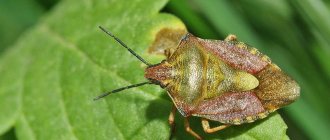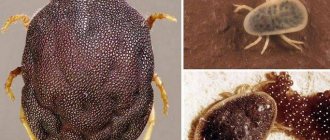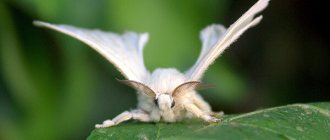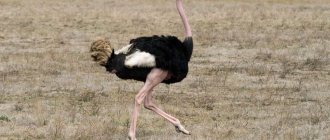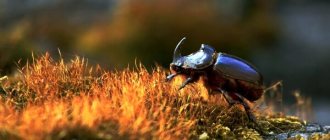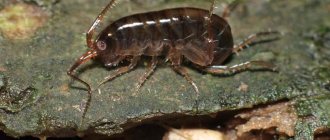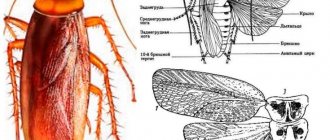Centipedes are arthropods consisting of 4 classes: labiopods, bipopods, symphylos and pauropods. Scientists identify approximately 13 thousand species of centipedes.
From the name it becomes clear that these creatures have a large number of pairs of legs. For example, centipedes living in central California have 750 legs, according to this indicator it is the record holder among its fellows.
Millipedes (Myriapoda).
Centipede: description
The centipede got its name due to the fact that it has 15 pairs of legs, quite thin, which reach a length of up to 3 millimeters. The centipede grows up to 60 mm in length. Thanks to this, the insect moves relatively quickly - up to 40 cm per second, which gives it the opportunity to quickly go to cover in cases of danger.
If you carefully examine the insect, you can see small hairs all over the body, and long whiskers grow on the head. Along the entire surface of the body you can find stripes that even extend to the paws. Therefore, the centipede resembles a scary beetle with a flexible, elongated body. A centipede is born with 4 legs, the number of which increases as the insect matures. During her life, a female centipede lays up to 60 eggs.
Centipedes (also called flycatchers) prefer living conditions with high humidity and lack of light. In people's homes, flycatchers choose to live in rooms such as bathrooms, all kinds of closets or basements. As a rule, centipedes appear in human homes before the onset of winter. During this period, the centipede feeds on ants, mosquitoes, flies, cockroaches, termites, spiders, etc. In other words, such a proximity between humans and centipedes is only beneficial for humans.
Those owners who know how the centipede lives and what it eats try to use it as a natural enemy of many insects, sometimes dangerous to humans. The flycatcher can sit motionless for a long time, waiting for its prey, after which it attacks its victim with lightning speed. This is achieved thanks to excellent vision and speed of movement. The flycatcher releases a venom that paralyzes its prey, after which it slowly eats its prey. If she manages to catch two insects at once, then she eats one and holds the other with her paws, since she has many of them.
Flycatchers (centipedes) do not bite humans or domestic animals. They also do not damage room furniture. Therefore, the fight against centipedes is carried out only because many owners do not know how this insect lives and what it eats. A centipede lives for about 7 years. It settles in human housing only to survive the cold. Upon completion, she moves to her natural habitat. When it is very cold, the insect hibernates. It is most active in the spring.
Types of centipedes
But more precisely, it is the insects and slugs they hunt, not humans, who should be afraid of the toxic composition of the centipede repellent liquid. Although if you get in their way, they will most likely bite you. Scientists reassure everyone who is worried: “Centipedes do not carry diseases.” These are not mosquitoes, among which the malarial one can creep in - centipedes cannot cause much harm to humans.
Many of these creatures have glands on the sides of their bodies that secrete poison. Therefore, it is better not to touch them with your bare hands, take care of your skin: their “defensive spray” is very caustic and blisters may appear on your hands! And, of course, do not rub your eyes after touching such a creature and wash your hands thoroughly.
But the one you should definitely be wary of is the scolopendra. This is one of the centipede family that people should avoid. The venom of scolopendra is somewhat reminiscent of scorpion venom in composition!
Classification
Centipedes do not form a fairly monolithic class, but are divided into groups so different from each other that many zoologists divide the class of millipedes into four different classes.
We will consider these groups at the rank of subclasses. The class of centipedes (Myriapoda) is divided into four subclasses, two of which are of greatest importance: 1. Dipopods (Diplopoda); 2. Lipopods (Chilopoda).
External differences between a centipede and a centipede
| Options | House centipede (centipede) | Scolopendra |
| Size | Up to 6 cm (grows throughout life). Individuals 2–3 cm long are more common. | Depending on the species, it can reach 15 cm. |
| Body Features | Slender flattened body. Long and thin legs. The color ranges from gray-yellow to bright brown. | Worm-like appearance. Armored body, brown color, powerful short legs. |
| Eyes | Scalloped. | None. |
How many legs
Arthropodologists can tell you how many legs centipedes have. They argue that the number of legs changes dynamically as the flycatcher grows and ages. And their number directly depends on the number of body segments. At first, the newborn centipede has 1 to 4 segments with 4 pairs of striped limbs.
As the body grows, new legs appear. In an adult, there are a maximum of 15 pairs. In this case, the outermost pair of limbs is longer than the others and more closely resembles whip-like antennae.
What do centipedes look like, where do they live, how many legs do they have? Answers to the most popular questions
We are surrounded by many species of these nasty centipedes. Among them there are the usual house centipedes, and quite dangerous monsters like centipedes. Imagine, you are lying in a bubble bath with a glass of wine, and suddenly this multi-legged monster appears in front of you out of nowhere?!
We think that each of us has seen a centipede close to us at least once in our lives. At first, people panic, start screaming and run away in horror. The same questions first appear in my head: “Who is this? How to get rid of it? Will he bite me? A little later, more logical and serious questions appear in your head. We have prepared answers for you that will cover all the “dark spots” on the topic of fighting these creatures.
Let us say right away that they cannot be classified as insects: from a scientific point of view, centipedes and insects belong to the same type (arthropods), but at this stage they diverge. Millipedes form the superclass of the same name, which belongs to the subphylum Tracheales. They are most often found in dark and damp places outdoors. For example, in a pile of leaves, under tree bark or stones, in beds and in mulch.
It is not difficult to recognize these aliens. They crawl only at night or in complete darkness. The bodies of centipedes are extremely mobile and clearly segmented: each segment has a pair of legs. Moreover, as you approach the tail, the length of the legs increases. Why - you ask? This allows the creature not to trip over itself and to move quickly. They have two poisonous claws on their heads, which people often mistake for jaws. Certain variations are possible with body color: it is usually gray with the addition of red, brown or pink. But sometimes you can see yellow stripes.
Where do centipedes live?
Where can you find the common centipede? Theoretically, she herself could fall on your face at night or peek into the shower during home spa treatments. But more often, centipedes live in warm and damp basements, closets and attics. Of course, they love bathrooms and greenhouses. There are also more inaccessible places. Experts recommend looking under concrete slabs and into all cracks, inside hollow walls, into sewer drains and boxes with old things. Moreover, it is much easier to “spot a centipede” in the dark: they are most active at night.
How many legs does a centipede have?
In general, they can have from 30 to 354 legs. One fun rule is that centipedes never have an even number of pairs of legs (always 5, 7, 9, 11, 13 or 15 pairs). The house centipede (flycatcher) grows legs as it matures, and they typically have 15 pairs of legs. It is surprising that the last pair of legs in an adult female is the longest - almost 2 times longer than the insect’s body itself. And if you see an individual that has less than 30 legs, you know that it is still small.
How does a centipede get into a human home?
A centipede that lives in the wild can accidentally get into a house without purpose, but an ordinary flycatcher prefers to hide in houses and apartments for the winter. It received this name because it catches and eats only flies. In the summer, it hides in the foliage, but when cold weather sets in, it moves into a person’s home. The maximum length can reach up to 60 millimeters. The color of the body is gray-yellow with blue or red stripes.
The body itself is divided into fifteen segments, each of which has legs.
The first pair of legs is larger than the others. They are used to catch prey. It is with them that she catches and holds the victim.
In general, the flycatcher does not adhere to a specific time of day; it is always active. You can find it on the walls of houses and barns, as it hunts small mammals.
Flycatchers are not dangerous to humans, they do not have powerful jaws and they simply cannot bite through human skin. However, if it bites a child, it can pierce his skin and thereby cause an allergic reaction. In general, flycatchers do not rush at a person on their own. This happens if they feel danger.
Flycatchers can be useful for human homes, as they destroy other insects. However, when household members encounter a flycatcher, they prefer to get rid of it, since the appearance is quite frightening.
Nutrition
They are carnivores. This is surprising, because although they look scary, they do not seem like predators. However, they do like to eat spiders, cockroaches, flies, crickets, moths, and soft-skinned insects (such as bedbugs, earthworms, and various arthropods).
For larger species of centipedes, such as the Amazonian giant centipede, such a treat would not be enough. Most often, the wild species feeds on snakes, lizards, birds, frogs, rodents and even bats.
Centipedes use poison to paralyze and kill their victims. However, there is no need to be afraid of them: the poison produced by centipedes is harmful only to small arthropods, but not to mammals. In rare cases, the poison can provoke allergies.
Centipedes feed as follows. Having caught the victim, they inject poison into them and hold it with strong jaws and paws until the insect is completely immobilized. Only after this do they start eating.
Centipedes also destroy insects that harm agriculture. In some countries, for this reason they are under government protection.
Features and life cycle
Like many other centipedes, such as the centipede, the flycatcher is an active predator. The arthropod is active both day and night. Spends a lot of time waiting for prey. One of the main features of the flycatcher is the speed at which it can move. She can cover 40 cm in 1 second.
The process of fertilization in these centipedes is very interesting. Mating in its usual form does not occur between a male and a female. The male, in the presence of the female, lays a spermatophore (a capsule filled with sperm). After this, he pushes the female onto him, who takes him in with the help of her genital appendages. After fertilization, the female lays eggs in the soil, covering them with a sticky substance.
A centipede hatched from an egg is similar in appearance to its parents, but has only 4 pairs of legs. With each molt, the number of limbs increases and after the fifth moult the flycatcher becomes an adult.
Defense Mechanisms
Due to their lack of speed and inability to bite or sting, centipedes' primary defense mechanism is to curl up into a tight spiral, protecting their thin legs inside an armored exoskeleton.
Many species secrete various foul-smelling liquids as a secondary defense through microscopic openings called ozopores located along the sides of the body.
Among the many irritating and toxic chemicals contained in the secretions are alkaloids, benzoquinones, phenols, terpenoids, and hydrogen cyanide.
Some are caustic and can burn the exoskeleton of ants, other insects, and the skin and eyes of large predators. Primates such as capuchin monkeys and lemurs have been observed deliberately irritating centipedes and rubbing chemicals on themselves to ward off mosquitoes.
Some of the protective compounds exhibit antifungal activity.
The bristly centipedes (order Polyxenida) lack an armored exoskeleton and stink glands. Instead, they are covered with numerous bristles, which Polyxenus flaviculatus separates and launches at the ants.
Reproduction process
It is unusual that an arthropod such as the flycatcher can secrete pheromones and sounds that attract the opposite sex.
To deposit his spermatophore, the male weaves silk threads in advance for this purpose. The female, running through, shifts this sac inside with her genital appendages and fertilizes herself. During the warm period, eggs are laid in the ground and covered with a sticky substance on top. The average number of eggs ranges from 50 to 60 pieces.
When flycatcher eggs hatch, they have only 8 legs. Their number increases only after the next molt. At first there are 10 of them, then 14, 18, 26. After a few more molts, there are about 30 of them. Newborn arthropods resemble adults, but in a smaller version.
The female stays near the babies for about 14 days, protecting them from troubles and bird attacks.
Habitat
The common flycatcher can be found in many temperate regions. In Russia, this is the Volga region, the southern regions, the insect lives in the northern part of Africa, Europe, the Middle East, and Mediterranean countries. Under natural conditions, centipedes hide under stones, fallen leaves, and plant remains. The domestic centipede hunts at any time of the day.
They move to human housing with the onset of autumn cold weather. Prefer dark and damp places:
- basement;
- bathroom;
- toilet.
During the winter, the insect hibernates and becomes active only when the weather warms up. In southern countries, centipedes are treated kindly, because they help exterminate pests.
In natural conditions
In early spring, after hibernation, insects begin to become aggressive. During the day they seek shelter in rocks and between stones, in cracks, and at night they go hunting. They orient themselves in space using their antennae. The eyes also play a big role in searching for food on the surface during hunting. Under unfavorable environmental conditions, such as drought and cold, centipedes may burrow or begin the migration process.
Under natural conditions, the centipede feeds on small insects.
Under natural conditions, flycatchers are also carnivores. Used for food:
- cockroaches,
- silver coins,
- snails,
- worms,
- flies and other arthropods.
With the help of antenna tentacles, they find prey by smell and touch. The fangs bite into the fly, the poison is delivered from the front leg. Upon completion of the process, the centipede is removed to a secluded place to digest food.
Literature[ | ]
- Shelley, R. M.,
2002. A synopsis of the North American centipedes of the Scolopendromorpha (Chilopoda), Memoirs of the Virginia Museum of the Natural History, Martinsville, 5: 1–108. - Zalesskaya N. T. (1978). Key to centipedes-drupes of the USSR. M.: Nauka, 1978. - 212 p.
- Zalesskaya N. T., Titova L. P. (1980). Labiopods (Chilopoda) // Results of Science and Technology. VINITI. Zool. invertebrates. 1980. - T. 7. - P. 63-131.
- Zalesskaya N. T., Shileiko A. A.
Scolopendromorpha (Chilopoda, Scolopendromorpha). - M., 1991.
Eating habits
Centipedes prefer to settle on objects where there is enough food for them: a large black cockroach, fly, flea, moth, spider, cricket or termite. In a word, they prefer to feed on representatives of those types of insects that are considered pests and cause serious trouble to people. On the legs of the front pair there are claws-jaws. With their help, the centipede holds the caught prey.
Centipedes feed on insects; all kinds of traps against them are ineffective
The centipede lives up to 7 years, all this time it can stay in a human home. During the hunting period, she sits on the walls and ceiling, waiting for her future victim. In one approach, the centipede is capable of killing several insects; it will eat them gradually. For humans, the bite of a centipede flytrap is not dangerous, since it only defends itself if it feels threatened.
How do they hunt?
They lie in wait for their prey using antennae that detect odors and vibrations. During a hunt, the centipede rises on its long legs, then rushes with lightning speed at the spotted prey. To hold it, powerful jaw processes are used.
The injected poison instantly paralyzes the insect. After eating, the flycatcher hides in a secluded place to digest food. When faced with a flycatcher, people often wonder if the centipede is poisonous. Yes, the insect has glands that produce poison to kill prey.
If there are several victims within the centipede's reach, it catches them all. Moreover, in the process of eating one midge, she holds the rest with her legs.
Interesting behavior
The flycatcher makes good use of its long legs. Can move at alarming speeds - the equivalent of over 64 kilometers/hour in human terms. This will scare even the most die-hard arthropod lover. Athleticism doesn't have to scare you. The house flycatcher is simply well equipped to stalk and catch prey.
Oddly enough, the severed leg will continue to move for several minutes after its owner leaves the stage. They shed even as adults and regenerate lost limbs.
They feed on spiders, bedbugs, termites, cockroaches, silverfish, ants, and other domestic arthropods. The poison is secreted through the forcipules. Not through the lower jaw, so they burn and do not bite. These are night hunters.
Despite their developed eyes, they rely on their whiskers to hunt. The antennae are sensitive to both odors and tactile information. They use mandibles and legs to hold prey. Thus, they can deal with several small insects at the same time.
To catch prey, they either jump on it or use their legs in a technique described as a "lasso". The use of legs to subdue prey is also described.
We suggest you read: How do worms get out of the human body?
They have adapted their feeding pattern to the type of danger the prey may pose to them. For wasps, retreat after applying the poison to give it time to take effect.
Population and species status
The centipede population is not in danger, since they are very prolific and have virtually no enemies. More often, the opposite task is faced - how to get rid of them if they have settled in a house or apartment. Despite the fact that flycatchers are not dangerous to people and even destroy harmful insects, living with them in the same living space will not be pleasant for anyone. This can be a very serious problem, as regular insect repellents are not effective.
It is necessary to change the conditions that are comfortable for these creatures and then they will leave on their own:
- centipedes love dampness very much, which means it is necessary to remove the source of high humidity - do not leave puddles or wet rags on the floor, fix the taps;
- You should ventilate the premises more often and, if necessary, install a ventilation system;
- destroy all insects in the house, as they can attract centipedes as a food source;
- remove all old trash, rotten boards, mold from the basement;
- close the entry routes inside the room for centipedes - install screens on the windows, repair the floors, and so on.
As soon as the living conditions cease to satisfy the flycatchers, they will immediately leave the territory. If these creatures have settled on a summer cottage, then you should not disturb them, as they eat many harmful insects. In some countries, for example in Ukraine, flycatchers are listed in the Red Book and are protected.
The centipede is not the most pleasant neighbor, but it is better to be “friends” with it since it benefits humans, effectively destroying many parasitic insects that are dangerous to people. This is exactly the case when appearances are deceiving and behind the vile appearance hides a little friend, and not a big enemy.
These little creatures were called centipedes because they have many legs. The word centipede does not mean that the insect has 40 legs. In fact, the number of their legs can be completely different, depending on the species, and there are more than 5000 of them. Typically, most of them have from 15 to 200 pairs of legs.
Economic importance
Millipedes are most common in moist forests, where they serve an important role in breaking down decaying plant material, although some live in grasslands, semi-arid habitats, or even deserts. A very small percentage of species live in the littoral zone (found along the seashore). Several species of millipedes are capable of producing light and are therefore bioluminescent.
Cylindroiulus sp.
Are centipedes harmful to humans?
In fact, apart from its terrifying appearance, the centipede is absolutely safe for apartment residents and for pets and other pets. As a rule, the flycatcher comes out to hunt at night, so many owners do not even suspect the existence of this insect in their home. If you do not try to pick it up (even in this case the flycatcher will not bite a person), then this may not end very pleasantly, since there is poison on the insect’s legs. This can lead to redness of the skin. To get rid of discomfort, just place your hand under a stream of cold water. Pets do not suffer in any way from such a neighborhood. And a person, if he does not do anything unnecessary or unreasonable, cannot suffer either.
Centipede bite. Danger
In general, the poison itself does not pose a danger to humans. Death can only occur when a person is bitten by about 1000 of these parasites. These pests run away from humans rather than attack them.
The centipede bite itself feels like a bee sting. Burning and redness around the bite is the maximum that a healthy person can see and feel. If a person suffers from allergic reactions, the consequences of the bite can last for two to three days (redness, burning, itching).
Actions to take after being bitten
The first step is to remove it from the wound. It is important to understand that when a centipede defends itself, it sprays much more poison than usual. therefore, it is necessary to remove the centipede only with gloves and quite carefully.
Next, you need to apply something cold to relieve itching and inflammation.
If a person is allergic, then it is worth taking some kind of anti-allergy drug for prevention.
People prone to allergic reactions should, of course, be wary of various types of bites, since the consequences of a bite may be less joyful.
If after a bite you feel unwell, tired, headaches and dizziness, be sure to call an ambulance, and until it arrives, just lie down and drink more water. Open all windows to bring in fresh air.
What happens if a flycatcher bites?
Most often, the flycatcher fails to bite through the skin, unless we are talking about delicate children's or very thin women's skin. If she does manage to pierce the skin and inject poison, the bite will feel similar to a bee sting, and the symptoms will also be redness, burning, itching. The flytrap venom is not dangerous for people; it can only cause harm if there is an individual intolerance or an allergic reaction.
The flycatcher may try to bite domestic animals, defending itself from them. As in the case of a person, she will hardly be able to bite through their skin. But even if this happens, its bite and poison will not entail negative changes in the condition of the pets.
Much more dangerous than flycatchers are centipedes, another type of centipede with which, out of ignorance, they are sometimes confused. Although the scolopendra bite is not fatal to humans (with the exception of tropical species of scolopendra), it is very painful and can cause severe swelling that does not subside for several days. Scolopendra venom is especially dangerous for small children and can kill a cat or other small animal.
How to deal with it
Despite the positive qualities that insects have, not every person can see them in their home. Insects, no matter how useful they are, provide too little pleasure. The fact that an insect can bite does not make it a good neighbor for humans. Getting rid of the centipede that lives with you at home requires a lot of effort, but initially you need to determine the reasons why it appeared in the house.
If a centipede appears inside a building, in a bathhouse or basement, it is recommended to remove all rotting wood or other organic matter and dry the room. It is also recommended to remove all vegetation and organic waste located near the house. Centipedes are attracted to corrugated cardboard and paper, as well as shredded tree bark and clumps of straw.
Centipedes do not live in large colonies, and if you see one of them, it is advisable to catch it, although this is quite difficult.
For those who do not have time to evict the centipede from the apartment without causing harm to it, an effective method is to use a toxic substance designed to destroy the flytrap.
The best thing is to turn to professionals involved in pest control, but it is worth remembering that in some countries the law is to protect these insects and their appearance in the apartment is considered a blessing.
To get rid of centipedes, you need to remove dead grass and rotten wood
Chemical control agents
The use of repellents or extended-spectrum insecticidal sprays, which have a high concentration, will help drive out multipedes that have multiped and come across even during daylight hours. There are no special preparations for house centipedes in the apartment.
Popular drugs:
- Aerosol Raid. Non-toxic product with lavender scent.
- Liquid Medilis-Ziper for dilution with water and spraying. It has a pungent odor and requires respiratory protection when working.
- A strong insecticide with lambda-cyhalothrin has no pungent odor and does not harm people or pets.
- Globol (odorless gel) has strong toxicity, flycatchers will not return soon.
- Great Warrior (gel) fights cockroaches and ants, but flycatchers and earwigs also do not like this product.
As a home remedy, you can sprinkle boric acid powder where centipedes run around the apartment.
Folk methods of struggle
Traditional methods of combating various insects are especially effective when their number is not too large. As a rule, products prepared on the basis of natural or other ingredients are more suitable as preventive agents. They do not act quickly, so it will take some time to completely get rid of unwanted guests. Products based on natural ingredients are practically harmless to people, children and pets. Therefore, most people prefer these methods of struggle.
Proven methods include:
- Use of boric acid. This is an inexpensive, accessible and safe product that has a detrimental effect on many insects. Centipedes are no exception and also die from such bait. But the use in the fight against this arthropod has its own characteristics, since the flycatcher does not consume food of this origin. You need to take boric acid powder and pour it into the cracks between the baseboards and the wall, as well as into other cracks where these insects can hide. But it’s better to prepare similar bait for cockroaches. When the cockroaches disappear, the flytrap itself will leave the apartment.
- Use of cayenne pepper. To do this, you will have to grind or dry, and then grind the burning product into a powder and scatter it in areas where insects appear. Centipedes, like other insects, cannot stand the smell of this plant, but they are unlikely to taste it.
Harmless ways
Eliminate the source of moisture because flycatchers cannot live without water.
For this:
- Clean the kitchen and bathroom, clean places where a rag rarely penetrates, add bleach and chlorine to the water, do not store garbage;
- Remove wet sources (wet rags and towels, replace the bathroom rug);
- Eliminate condensation, wipe the walls and ventilate the bathroom;
- Install, if required, dryers and fans;
- Do not leave water in trays with indoor plants.
In a private house - clean the basement, get rid of mold and dampness.
If there are leaks, repair or replace leaking plumbing fixtures and pipes. Re-glue the peeling wallpaper and return the fallen tiles to their places.
Block the crawling paths of centipedes: fill cracks and crevices with silicone sealant, cover windows with mosquito nets, and cover ventilation ducts with fine-mesh grilles. Don't forget to clean the grates regularly.
Remove insects - the food of centipedes. But poisons that act on cockroaches and flies will not affect flycatchers - they develop a persistent addiction.
It is not difficult to remove using a humane method. Centipedes remember what happened and how they felt. With the caught animals, which were taken out and released on the street away from the house, others will also leave.
Preventive actions
To prevent a centipede from starting up in an apartment, you need to avoid excessive dampness and remember that the creature will not live in a dry room. To do this, the following preventive measures should be taken:
- systematic cleaning of “wet” rooms: bathroom and shower, thorough dry wiping of pipes and tiles;
- timely sealing of cracks and crevices in windows, on the floor, at the joints of water pipes;
- fighting insects in the house;
- destruction of mold in the apartment;
- Do not allow water to stagnate in the trays of flower pots;
- Periodically you need to ventilate and dry your home.
Natural enemies
The natural enemies of the centipede scutiger are birds and other animals. But quite a few animals prefer centipedes as food. Therefore, the main threat to them is a person who exterminates all the “creepy creatures” that come his way.
Disinsection services remove not only harmful creatures from homes, but also useful creatures such as flycatchers.
Millipede populations are declining due to ongoing human activity in the areas of logging, farming and pesticide use. The extinction of this species could have a negative impact on the ecosystem, which could lead to even more harmful insects.
Evolution
Millipedes are among the first animals to colonize the earth during the Silurian period. Early forms ate mosses and primitive plants.
There are two main groups of millipedes, all members of which are extinct: the archipolipods (“ancient, many-legged”) and the arthropleurids, the largest known terrestrial invertebrates.
The earliest known land creature, Pneumodesmus newmani, was a 1 cm long archipolypodanus that lived 428 million years ago.
Live bands
- Octoglena Sierra;
- Octoglena sierra (Colobognatha, Polyzoniida);
- Anadenobolus monilicornis;
- Anadenobolus monilicornis (Juliformia, Spirobolida);
- Harfafa Haydeniana;
- Harpaphe haydeniana.
The history of scientific classification of centipedes began with Carl Linnaeus, who, in the 10th edition of Systema Naturae, 1758, named seven species “Insecta Aptera” (wingless insects).
Folk signs
As for folk superstitions regarding why centipedes should not be killed, the following should be noted:
- A centipede that appears in a person’s home indicates that some news or news awaits the owner.
- An encounter with a running centipede foretells heavy rain.
- If centipedes appear in large numbers in an apartment, they should not be destroyed. You can simply catch one insect and release it outside, while others will leave the home on their own.
Notes[ | ]
- Kluge N. Yu. Modern taxonomy of insects. Principles of taxonomy of living organisms and the general system of insects with the classification of primary wingless and ancient winged insects. - St. Petersburg: Lan Publishing House, 2000. - P. 146-157. — 336 p. ISBN 5-8114-0216-3
- ↑ 1 2 Minelli, Alessandro.
Class Chilopoda. — In: Zhang Z.-Q. (Ed.) “Animal biodiversity: An outline of higher-level classification and survey of taxonomic richness.” (English) // Zootaxa. - Auckland: Magnolia Press, 2011. - Vol. 3148. - P. 157-158. - W. A. Shear.
Early life on land (undefined) // American Scientist (English) (Russian. - 1992. - T. 80. - P. 444-456. - Foddai, D.; Pereira, LA; Minelli, A. (2000). A catalog of the geophilomorph centipedes (Chilopoda) from Central and South America including Mexico. Archived March 14, 2016 on the Wayback Machine - Amazoniana. v. 16, no. 1/2 p. 59-185. 2000.
- William A. Shear, Gregory D. Edgecombe.
The geological record and phylogeny of the Myriapoda // Arthropod Structure & Development. — 2010-3. - T. 39, issue. 2-3. — P. 174—190. — ISSN 1873-5495. - doi:10.1016/j.asd.2009.11.002. - Zhang Z.-Q.
"Phylum Athropoda". — In: Zhang, Z.-Q. (Ed.) Animal Biodiversity: An Outline of Higher-level Classification and Survey of Taxonomic Richness (Addenda 2013). (English) // Zootaxa / Zhang Z.-Q. (Chief Editor & Founder). - Auckland: Magnolia Press, 2013. - Vol. 3703, no. 1. - P. 17–26. — ISBN 978-1-77557-248-0 (paperback) ISBN 978-1-77557-249-7 (online edition). — ISSN 1175-5326.
Is it necessary to get rid of it at the dacha?
If you have a garden and a vegetable garden adjacent to your dacha building, and that’s where you noticed flycatchers, you don’t need to touch them. Moreover, destroy it. They will bring you great benefit and will help exterminate various pests that attack crops and cultivated plants. The centipede itself does not eat plants and root crops; it is carnivorous.
Preventing the appearance of centipedes in a house or apartment: tips
If you keep your house clean, ventilate, and prevent dampness in the bathroom and toilet, centipedes will not start.
Despite the unpleasant appearance of the centipede, it brings only benefits to people. And if you don’t want to meet her in a house or garden, then you need to clean up the area and prevent humidity in the premises.
To prevent centipedes from starting in your house or apartment, you need to:
- Repair leaking sewer and water pipes.
- Remove everything unnecessary under the bathtub and in the toilet.
- Avoid leaving puddles or wet rags on the bathroom floor.
- Wash off the mold, establish ventilation and ventilate rooms with high humidity.
- Make sure that the kitchen, bathroom and toilet are free of flies, cockroaches, moths, fleas, and silverfish.
- Seal all the cracks in the apartment or house with cement mortar, close the cracks in the wooden floor, and put a mosquito net on the windows.
- Remove rotten boards, old paper and any debris from the basement.
- In the spring, remove last year's leaves from your garden plot in time.
So, if you remove potential food for the flytrap, put things in order in your house, or make living conditions for the centipede not entirely comfortable, it will leave your house or apartment on its own.
Sources
- https://prusakam.net/mnogonozhki-v-kvartire/
- https://stoppestinfo.com/ru/454-vse-o-sorokonozhkakh.html
- https://moypitomec.ru/poznavatelno/sorokonozhka.html
- https://zoolog.guru/drugaya-poleznaya-informacia/kak-izbavitsya-ot-sorokonozhek-v-chastnom-dome.html
- https://parazitdoma.ru/drugie-parazity/muholovka
- https://pest-destroy.ru/nasekomye/mnogonozhki-skolopendry/mnogonozhka-osobennosti-stroeniya-tela-osobennosti-razmnozheniya/
- https://halal-eko.ru/rybki/kak-vyglyadit-muholovka.html
- https://beetlestop.ru/nasekomoe-sorokonozhka/
- https://vredinfo.ru/komary/nasekomoe-muholovka
- https://bioros.net/nasekomye/sorokonozhka-doma-chem-opasna-i-kakoy-vred-nanosit.html
- https://aptekaml.ru/lechenie/sorokonozhka-doma-chem-opasna-i-kakoj-vred-nanosit.html
- https://top-cat.ru/chto-est-mnogonozhka/
- https://combat-dez.ru/sorokonojka-jivyshaia-v-domah-otkyda-ona-beretsia/
- https://izbavitsya-ot-vrediteley.ru/kvartirye-mnogonozhki.html
- https://prusakam.net/sorokonozhka-v-kvartire/
- https://TaraKlop.ru/mnogonozhki/muholovka/
- https://KlopaBei.ru/tarakany/sorokonozhka-v-kvartire-primeta.html
- https://heaclub.ru/sorokonozhki-v-chastnom-dome-kvartire-prichiny-poyavleniya-narodnye-primety-kak-izbavitsya-ot-sorokonozhek-v-chastnom-dome-kvartire-sredstvo-dlya-borby-otrava- profilaktika-poyavleniya
[collapse]
